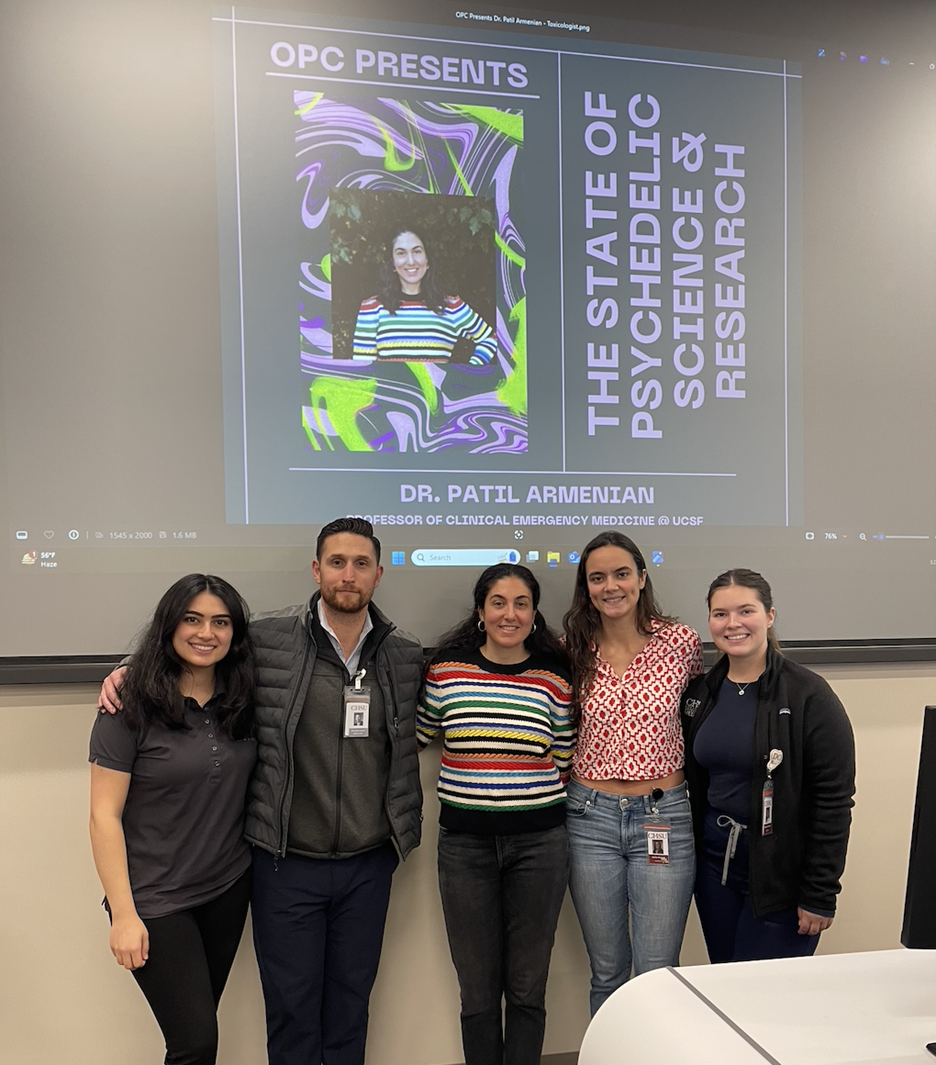CHSU Overdose Prevention Committee Hosted Emergency Medicine Physician, Toxicologist, and Psychedelic Science Expert, Dr. Patil Armenian
January 17, 2025

Photo Caption: Dr. Patil Armenian (middle) accompanied by (left to right) OPC Research Sub-chair Negin Fadaee, OPC Faculty Advisor Dr. Francisco Ibarra, OPC Chair & Sub-chair of Interprofessional Coordination Aicha Naouai, and Internal Events Sub-chair Mariya Leshchuk.
Written by: Aicha Naouai, CHSU Medical Student
The Overdose Prevention Committee (OPC) at California Health Sciences University College of Osteopathic Medicine (CHSU-COM) concluded the 2024 year with a unique event titled, “The State of Psychedelic Science and Research” led by Patil Armenian, MD, a dual board-certified Emergency Medicine and Medical Toxicology physician.
Dr. Armenian is an Attending Emergency Medicine Physician at Community Regional Medical Center (CRMC), Professor of Emergency Medicine at the University of California, San Francisco (UCSF), and Co-Director of Medical Toxicology at CRMC.
Dr. Armenian provided an in-depth exploration of psychedelic compounds, covering their pharmacology, classification, and historical use. She discussed the resurgence of psychedelic research and its promising impact on improving patient care. The session highlighted the evolving nature of psychedelic science and its role in bridging the gap between traditional medical practices and emerging therapeutic approaches; a topic Dr. Armenian noted was never covered during her own extensive medical education.
Psychedelics are also referred to as hallucinogens, entheogens, or empathogens/entactogens due to their use in spiritual activities and ability to increase a person’s emotional openness and sense of empathy. These substances are classified into various categories based on their chemical structures, including Tryptamines (e.g., Psilocybin, Ayahuasca), Lysergamides/Ergolines (e.g., LSD, Ibogaine), and Phenethylamines (e.g., MDMA, Mescaline). Despite their structural differences, these compounds primarily exert their effects through interacting with 5-HT2A serotonin receptors, which are distributed throughout the body, in nearly every tissue and cell. Other receptors through which psychedelics exert their pharmacological effects include NMDA, dopamine, GABA, and kappa opioid. However, Dr. Armenian emphasized “it’s almost always about serotonin.”
In the 1970s, LSD (“acid”), psilocybin (“shrooms”), MDMA (“ecstasy/molly”), DMT (“ayahuasca”), and mescaline (“peyote”) all became classified as Schedule I substances, which labeled them as agents with no accepted medical use and high potential for abuse. Prior to this schedule change, research involving LSD was already underway and the substance was marketed as a psychiatric medication under the brand name Delysid. Following this regulatory action, psychedelic research and use moved underground, lacking proper oversight. Now, with the resurgence of interest in psychedelic therapy, strict adherence to study trial best practices will ensure these substances legally enter the clinical setting, with clearly understood risks and benefits.
Dr. Armenian emphasized key aspects of current psychedelic research, noting how it differs from studies conducted during the 1950s, 60s, and 70s. Notably, she highlighted the importance of the setting in which the psychedelic compound is administered, as well as the participant’s mindset, psychosocial education, and personal experiences they bring into the encounter.
During the event, Dr. Armenian cited fifteen published studies, covering a range of topics including the use of psilocybin for end-of-life care and treatment-resistant depression, LSD-assisted therapy for anxiety, and MDMA-assisted therapy for chronic, treatment-resistant post-traumatic stress disorder (PTSD). In several of these studies the benefits were sustained throughout the follow-up period. However, further research is needed to ensure psychedelic safety and identify more effective placebo controls to secure Food and Drug Administration approval.
The current published data supporting the clinical use of psychedelic compounds is promising, and CHSU’s future physicians could be prescribing them to patients in the future. Therefore, CHSU students are highly encouraged to familiarize themselves with these agents early in their career.